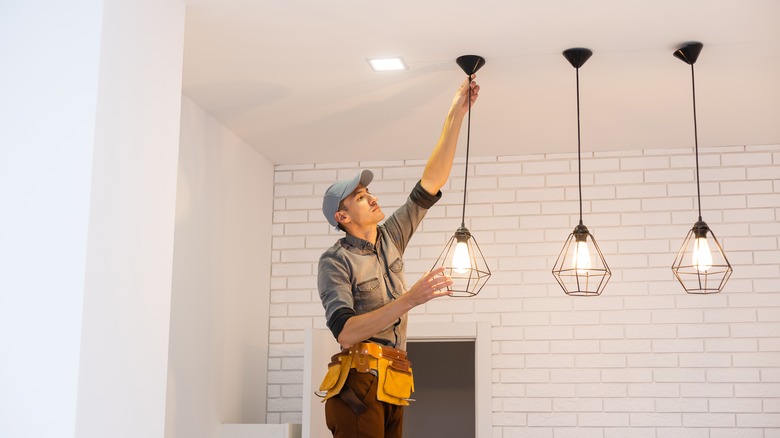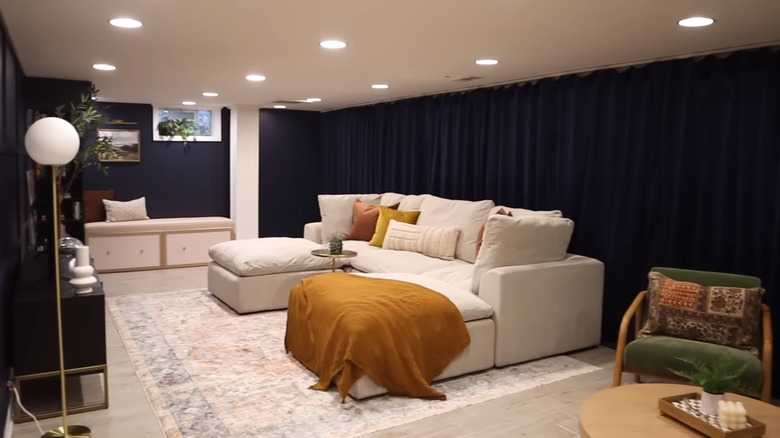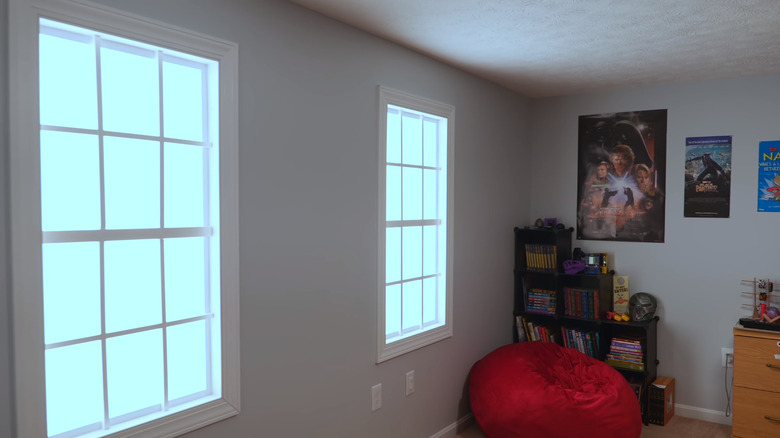Enhance The Look Of Your Basement With These Lighting Ideas
Finishing a basement can add valuable living space to your home, allowing you to have that extra family room, play area, games room, or even a home bar. But there's one inherent issue with basements: They usually receive little or no natural illumination. A good lighting plan is key to making any space feel well-designed, but it's even more important in basements. With the right fixtures, you can keep your basement from feeling like a cave, and turn it into a well-lit, cozy, and functional space that feels finished off and stylish.
If you want to achieve a luxurious-looking, layered lighting plan, you need to go beyond the basics. A single bulb hanging overhead will give you some lumens to see by, but that's about it. Fortunately, there are lots of clever lighting ideas you can leverage, from adding charm with string lights to installing LED strips, picture lights, neon signs — you name it. Sit back and keep reading to shed some light on the best ways to illuminate your basement.
Install track lights for lots of versatility
Track lights might not be the trendiest of fixtures, but they can be uber practical. Track lighting allows you to illuminate multiple bulbs from one electrical box without having to run lots of additional wires through your ceiling. If you're keeping some exposed pipes, steel beams, or ducting in your basement, track lights could tie in perfectly with this look. Track lighting is also coming back in style, and there are lots of updated designs that don't feel straight out of the '90s, such as this one in matte brass on Amazon.
Invest in a statement light
One of the simplest ways to make a basement feel cozy and stylish is to install a statement light fixture. This can help the space feel less sterile and create a focal point to ground your design. Statement lights can be anything from a crystal chandelier to a modern, sculptural pendant like this one on Amazon. If you're working with a low ceiling, you may need to position hanging light fixtures above furniture or surfaces like countertops. Try to get a good idea of furniture layouts ahead of time so you can place your statement lights in the right places.
Use recessed lights to create even illumination
Although they require more work to install than track lighting, recessed lights are the ultimate solution if you're looking to strongly (and uniformly) illuminate a big, dim room. Provided they aren't too far apart, recessed fixtures can evenly light up a large area with enough lumens for even the most intricate tasks, like sewing and crafting. Because they're sunk into the ceiling, recessed lights are also ideal for spaces that don't boast a whole lot of headroom, like basements. For even lighting, space cans roughly 4 to 6 feet apart.
Add ambiance with wall sconces
When it comes to setting a mood, wall sconces are where it's at. They can provide task lighting and highlight attractive features like artwork or architectural elements, such as an exposed brick wall. Some other great spots for sconces are above countertops, next to large mirrors, or flanking a fireplace. If you have seating that's close to a wall, such as a sectional sofa or accent chair, you can also install wall sconces on either side in place of table lamps. If you don't want to hardwire them, you can mount sconces that plug in, such as these swing arm sconces.
Light up your cabinets
A simple LED strip can turn a glass-fronted cabinet into an attention-grabbing feature or elevate an open shelf behind a home bar. Lighting up the underside of cabinets in a basement kitchen is also a smart move. Under cabinet LED strips can be a valuable source of task lighting, and they also add a ton of ambiance, making them a must-have kitchen feature for designers like Jenn Todryk. You can have an electrician run inexpensive lengths of flexible LED strips (which are available on Amazon for under $16) under or within your cabinets. If you want a plug-and-play solution, you can also pick up something like these under-counter lights.
Use picture lights to highlight art and decor
Besides using them to illuminate canvases and framed images, you can also install picture lights above bookcases, open shelving, or anywhere else where you'd like a long, wide wall sconce. If you're getting an electrician to wire your basement, now is the time to pick positions for your picture lights. Or, opt for plug-in versions, like these ones on Amazon. Ideally, you'll want to have an outlet situated below the spot you want to place your picture light. You can also pick up a few battery-powered models for less than $27 on Amazon to light up your wall art.
Get a cozy glow going with string lights
What better way to brighten up a dreary basement than with some string lights? Not only do they add oodles of soft cheer, but you also don't have to be an electrician to install a stunning array. To illuminate any dark corners, hang a few lengths where your walls and ceiling meet. You can also create a feature wall or drape them around any doorframes. If you don't want to put nails in your walls, a few adhesive hooks can do the job, such as these round Command cord clips.
Set the vibe with some neon signs
Creating a below-ground-level chillout zone? Neon signs can double as fun accent lighting and décor. Perfect for creating a bar vibe, you can buy pre-made neon signs from Amazon that sport sayings like "order here." For a basement office or workout area, you might want to look for something on the aspirational side, like this "Don't Quit" sign on Amazon. Or maybe you have a family saying or inside joke? Then a custom sign (which you can also get through Amazon) could be the perfect way to go.
Don't forget about floor lamps
If you're furnishing a basement, don't forget about the power of floor lamps. They can help add visual dimension and be a source of task lighting. Floor lamps can also instantly brighten up dark, empty corners and make small seating vignettes feel finished off. For instance, if you want to create a cozy reading nook, a side table, comfy chair, and floor lamp are all you need. If there isn't an outlet nearby, look for clever ways to hide the cord, such as running it under a rug.
Use pendant lights to help demarcate different zones
Pendant lights are a perfect way to add style to a basement and divide it into distinct zones. For instance, if you have a bar counter, installing a row of pendant lights above it will imbue the space with sophistication and provide a valuable source of task lighting. If you don't feel like hardwiring in new lights, you can also opt for battery-operated or plugin pendants, such as these metal ones on Amazon. Worried about exposed cables? Add a few lengths of cord cover to your Amazon cart and paint it the same color as your ceiling.
Fake a window
The biggest problem with basements is their lack of windows, but did you know you can fake them with an LED light box (like this one from LightUp)? To pull off the hack, you'll need to measure and cut a hole in your drywall, wire and mount the light box, and then finish it off with some window trim for a realistic look. To make the "window" appear even more real, install a curtain rail and flank it with some gauzy drapes that will let lots of light through if you choose to draw them.
Install cove lighting
If you want to create an ambient glow in your basement, then you should definitely consider installing cove lighting. To achieve this, you will need to run the power cable up through your drywall, mount an LED strip a few inches below the ceiling, and conceal this with crown molding. You can either use regular molding adhered to a backer strip of lumber (cut at an angle), or you buy crown molding that's specially made for indirect lighting from a company like Orac Decor.
Fake a skylight
Installing a skylight can be a great way to bring more sun rays into dark lofts, but it isn't always an option in basements. Fortunately, you can fake the look with a faux skylight, like this one from Pese Tech, which can mimic the look of sunrises, sunsets, and blue skies and increase the ambient lighting in your space. To install, you will need to measure and cut a rectangle out of the ceiling, hardwire the panel, insert it into the opening, and then finish off the edges with some lengths of trim.
Install hidden accent lights
Are you designing a theater room in your basement? If so, consider installing hidden accent lights that will create a subtle, glamorous glow. All you have to do is mount some lengths of LED strip lights along the edges of your walls. If there isn't a convenient place to conceal them, you can choose to mount the strips behind any beams or rafters, or make your furniture "float" by adding some strips underneath the seating. You can even get strip lights on Amazon that can change color to music or theater sounds and connect to your phone via an app.
Illuminate your stairs
If you have stairs leading down into your basement, illuminating them won't just look snazzy, but it can also reduce tripping hazards. You can opt to install sconces on the wall, run hidden LED strips underneath the stair treads, mount linear step lights — you name it. LED strips are probably the simplest solution if you're looking to do the job yourself. If you purchase some that can plug in, like this motion-activated stair light, you won't have to do any hardwiring. By running the strip directly beneath your handrail, you can conceal it and cast a warm glow onto the stair treads.


